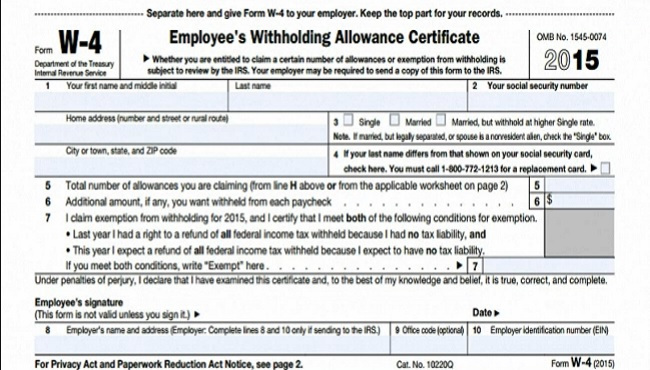
If you have ever worked outside your home and earned more than money for allowance, you have had to complete one of the above. That process can seem simple but the process is also deadly to one’s finances if it isn’t handled appropriately. The Human Resource Department of your job is not allowed to help you complete these forms and rightly so. No company wants to be liable for an employee who loses money due to incorrect filing status. However, most people will not admit to needing help completing their forms. Some people are unaware of the difference between the forms, some aren’t sure what to use and which works in their best interest, but they are all important to one’s financial future and their tax situation.
W-4’s
Anytime you are hired as an employee you must complete this form. The information on this form determines how much Federal Taxes are withheld from your check. Factors that determine the amounts deducted are whether one is married or single and the number of exemptions you choose. Single and 0 means that more taxes are deducted from your wages. Single and 1 less taxes deducted. You can claim as many deductions as you like, however that number will make multiple decisions for you both in the close future and the long-distance future. Most people prefer to bring home as much money as possible on their check. Listing a lot of allowances (LINE 5 ON W-4) will prevent one in some cases, a delay in paying Federal taxes on their weekly, bi-weekly, or monthly (based on how your company pays you) checks. However, a delay of paying taxes doesn’t mean that you don’t pay taxes. For most, it just means that you aren’t paying taxes during the year which could be detrimental when one files his or her taxes in April of the following year. For most workers that’s never good because while you can make payment arrangements, most people look forward to a return of tax dollars and not paying in tax dollars and who wants to owe the IRS?
To make sure that you have completed your W-4 Form correctly, your federal withholding should be roughly 10% or more of your Gross Wages (wages before taxes are deducted). You can check this each time you are paid just to make sure you are on track with the withholdings. Medicare and social security will always be deducted from your wages regardless.
W-9
Anytime you work for someone as a CONTRACT Position, a W-9 should always be submitted. Contract in most cases is an implication that #1 – the employer has had multiple turnovers and doesn’t want to add to their cost of employment and will bring on new talent for 90 days on a trial and error basis. The employer withholds no taxes which means the employee is responsible for paying his or her taxes as year-end. #2 – The other reason for using contract workers is when a company has sporadic need for assistance. Either way, at year-end one must have a record of all finances received. A W-9 submitted ensures that at the end of the year the employee will receive his or her 1099 Form for purpose of filling taxes.
1099’s
These forms are received at year-end from employment you have as a contracted employee.
W-2’s
These are received each year and are to be mailed out no later than January 31st of the following year of your employment with any company that paid you a wage and deducted Federal withholding from that wage. A W-2 is description of your time on any job describing wages earned, taxes withheld, any 401K withheld, insurance paid with a particular-company for one calendar year. If you had more than one job in a calendar year, you will receive more than one W-2.
When you change jobs, always keep your last check stub, (you should keep each check stub but especially the last one). The last stub is a record of your Federal withholdings for that year and that period-of-time on that job. Remember to always update your former employers with new addresses as you move.
GET AND STAY IN THE KNOW, THE MORE U KNOW THE GREATER U’LL GROW!
Ask until you get clarity.




